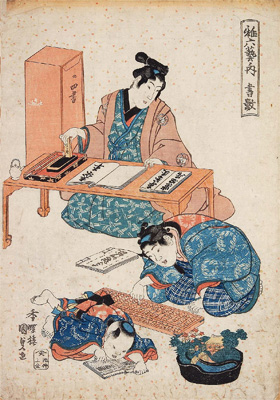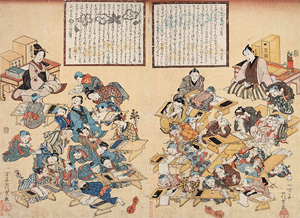Great-Edo Culture
Edo learning / Jihon and EzōshiWhat are "terakoya"?
Calligraphy and Abaccus
(Osanarikugei No Uchi Shosū)
Painted by Utagawa Kunisada
Terakoya (temple schools) were public educational institutions that provided children with an education of reading and writing and in some places taught the use of the abacus. They existed not only in Edo but in also in other towns and villages throughout Japan.
Thousands of terakoya began receiving pupils throughout the country during the Tempō era (1830-1844). The number of terakoya at the end of the Tokugawa Shogunate seems to have reached some thirty or forty thousand and it was these institutions that contributed to the high levels of literacy among ordinary people.
[First Volume, Last Volume]
(Bungaku Bandai no Takara (Shinomaki, Suenomaki))
Painted by Issunshi Hanasato
1844-1848 (During the Kōka period)
An example from the beginning of the Meiji period, according to a survey conducted by the Tokyo government, the majority of terayako teachers were Edo citizens. Many were men, but in urban areas, especially in Edo, there were also female teachers. The teachers would consider the professions of the parents of the children who came to learn at terakoya and also their desires and would carry out education respectively with individual curriculums tailored to these needs and circumstances.
* To view more explanation, please click the each image.




